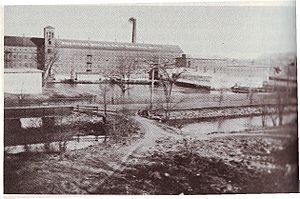Waterford, Rhode Island facts for kids
Waterford is a small village found in both North Smithfield, Rhode Island and Blackstone, Massachusetts. It's a unique place because it sits right on the border between these two states. Two important rivers, the Blackstone River and the Branch River, meet just south of the village.
Contents
Discovering Waterford's History
Waterford has a rich history, especially linked to its rivers and early industries. It was once a busy center for making textiles.
How Waterford Started
The village of Waterford began in 1824. A clever businessman named Welcome Farnum bought land there. He built a dam on the Branch River and then created the first fabric factory, called Red Mill.
Farnum named the village "Waterford" because many of the workers in his factory came from a city called Waterford in Ireland. This shows how different cultures helped build the community.
Mills and Factories
More factories were built in Waterford during the mid-1800s. These textile mills were very important for the area's economy. They provided many jobs for people living nearby.
Important Buildings
Waterford is home to St. Paul's Church, which was built in 1851. This church originally served the many Irish families who lived and worked in the village. It's special because it sits right on the border between Rhode Island and Massachusetts. Next to the church, you'll find a school and several local businesses.
Rivers and Borders
The location of Waterford, right where two rivers meet and on a state border, makes it interesting. The rivers were vital for the early mills, providing power.
The Blackstone River
The Blackstone River is a significant waterway in the region. It played a big role in the history of the Blackstone Valley, powering many factories. Today, it's a place for nature and recreation.
The Branch River
The Branch River also flows through Waterford. Its meeting point with the Blackstone River is a notable natural feature. These rivers shaped the village's development.
Images for kids





